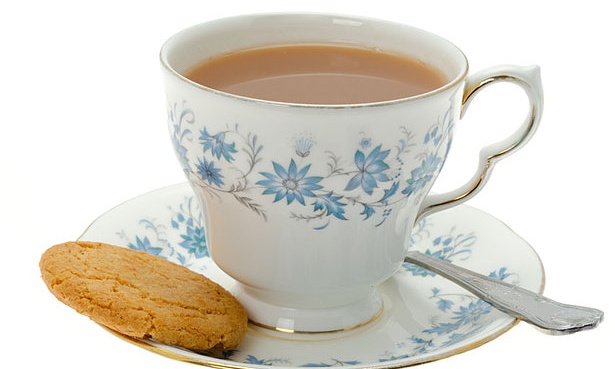 |
| Civilized. |
- Affordable!
- Efficient calories
- Slow-burning energy
- Caffeine and sugar!
- Vitamins, minerals, antioxidants
 |
| SAVAGE! |
At the age of 43, I suddenly found myself living in a cold room in a brick house in Reading, Berkshire, UK (ENGLAND!) with five twenty-somethings. How does this happen? I was a poor graduate student of non-traditional age, that's how. NON-TRADITIONAL, I say!
Side note: My flatmates called me a "savage" when they discovered that I drank my tea without milk and left the teabag in. They also accused me of being a hippie when they found my stash of Earl Gray.
Did I mention I was poor? I was seriously, ridiculously poor because the exchange rate was HORRIBLE at that time. I lost a ton of weight because I couldn't afford to take the bus or eat. I walked everywhere, rain or rain (HAHAHAHAHA! Not funny).
I was forced to get creative with my menus.
One thing I didn't really expect was the high quality of the groceries in England. All we Americans ever hear about is how bland and overcooked English food is. So, yes! Excellent groceries, anyway.
Over the first few weeks/months, I honed my breakfast down to its most basic awesomeness and I still love it. It's totally delicious and honestly keeps me going for a long time, even when I'm walking through windy, rainy, hilly, beautiful English cities.
Breakfast for Longevity, Energy, and Financial Peace
- cup Earl Gray tea with a teaspoon of sugar
- 2 squares 85% dark chocolate
- 2 tangerines
- small handful raw nuts
Estimated Calories
Tea and sugar: 162 squares dark chocolate: 150 to 200
2 tangerines: 100
Raw nuts:200
Total Calories: 466-506
The Mix
Tea and sugar: antioxidants, polyphenols, caffeineChocolate: antioxidants, caffeine, fat, carbs
2 tangerines: Vitamin C, Vitamin A, carotenoids, calcium, iron, carbs, antioxidants, fiber
Raw nuts: good fats, carbs, protein, calcium, iron
You're ideally looking for a mix of protein, fat, and carbohydrates. This provides a slow-burning fuel to keep you going until lunch.
Protein, fat, and carbs are provided here with the nuts, the chocolate, and the tangerines. You're also getting fiber, vitamins, antioxidants, minerals, and let's not forget the all-important caffeine.
- fat helps body absorb vitamin c
- protein helps body absorb carotenoids
- vitamin c helps body absorb iron/minerals
- pairing of caffeine and antioxidants increases health benefits
Why it works (studies and summaries)
Black tea
Berkeleywellness.com has an excellent summary of recent research. Check it out. It's pretty amazing.From their page:
Here’s a look at some of the research:
- Cardiovascular health. Of all the potential benefits of tea, those involving cardiovascular disease are “the most promising,” according to Jeffrey Blumberg, Ph.D., professor of nutrition science at Tufts University and chairman of the tea symposium. Many (but not all) observational studies have found that people who consume moderate or high amounts of green or black tea (or flavonoids from all dietary sources) have a reduced risk of cardiovascular disease and, especially,stroke—usually with higher consumption linked to greater benefit. Furthermore, most research has shown that tea can slightly lower LDL (“bad”) cholesterol and blood pressure, as well as improve blood vessel functioning, reduce inflammation, inhibit blood clotting and have other cardiovascular effects. In 2013 a British review of 11 clinical trials concluded that tea seems to improve blood pressureand cholesterol levels, but that longer, better studies are needed to confirm tea’s benefits in terms of cardiovascular disease prevention.
- Cancer. In lab studies, green tea extracts and tea polyphenols have been shown to inhibit a wide variety of cancers; black tea has been less studied. There are many theories as to how tea polyphenols may have anti-cancer effects—for instance, by inducing cell suicide in cancer cells and by inhibiting insulin growth factor (a protein involved with cell proliferation). However, the many human studies looking at the association between tea consumption and various types of cancer—such as breast, colon, prostate, oral, liver, ovarian and lung cancer— have had conflicting results. So farm there is insufficient support for claims that tea can help prevent or treat any cancer.
- Diabetes. Most research has linked green or black tea or compounds in tea (such as catechins) to improved blood sugar control or reduced risk of type 2 diabetes. For instance, a 2012 study in BMJ Open looked at data from 50 countries and found that high consumption of black tea was strongly associated with a reduced diabetes risk. And a 2013 Chinese meta-analysis of clinical trials suggested that green tea helps reduce blood sugar.
- Weight control. There’s some evidence that tea, especially green tea, has a modest weight-loss effect. It’s theorized that tea catechins and caffeine help boost fat burning, at least slightly and temporarily. A 2013 analysis of data from the large National Health and Nutrition Examination Survey linked tea consumption with lower weight and smaller waist size; this was not true of iced tea. But not all studies have found an effect on weight. One reason for the inconsistent findings is that the stimulant effect of caffeine depends largely on whether people are used to it or not; if they consume it regularly, they quickly build up a tolerance. What about concentrated green tea extracts, which are often marketed as diet supplements? A 2012 Cochrane review of 14 clinical trials concluded that they do not cause weight loss in overweight or obese people.
- Brain health and mood. Lab studies support the potential role of tea in improving cognitive function. Studies in people are limited, though. For instance, in a study in Japan in 2006 and one in China in 2008, older people who regularly drank green tea were found to have a reduced risk of cognitive impairment compared to nondrinkers. Tea can increase alertness, thanks largely to its caffeine. It may also help enhance concentration and learning ability because of its theanine (an amino acid), which at the same time promotes relaxation. Of course, the experience of drinking a hot aromatic beverage, along with the associations that come with it, can contribute to the calming effect.
- Parkinson’s disease. A 2008 study in the American Journal of Epidemiology found that people who drank the most black tea—but not green tea—had a much lower risk of Parkinson’s disease than nondrinkers. According to a paper in the Annual Review of Nutrition in 2013, human and lab studies suggest that tea or constituents in it may help protect against Parkinson’s and other neurodegenerative diseases. Coffee seems to be similarly protective.
- Bone health. Lab studies show that tea polyphenols have beneficial effects on factors affecting bone mass and bone strength and thus may help protect against osteoporosis. Bones may also benefit from the fluoride in tea. Most studies of postmenopausal women have linked long-term consumption of tea (usually green and often high intakes) or tea extracts with greater bone density, but there are discrepancies among the results. “More basic research and human studies are warranted,” the researchers at the symposium concluded.
- Dental health. Researchers have found that tea has antibacterial effects and thus may reduce levels of bacteria that cause cavities and contribute to gum disease. Like bones, teeth may benefit from the fluoride in tea. At least two Japanese studies have linked green tea consumption with a reduced risk of tooth loss.
Dark Chocolate
Calories: between 150 and 200High in Iron: the darker, the better. An ounce of 85% dark chocolate can provide up to 25% of your RDA!
The American Chemical Society has a FASCINATING summary of chocolate research!
We found that there are two kinds of microbes in the gut: the ‘good’ ones and the ‘bad’ ones...the good microbes, such as Bifidobacterium and lactic acid bacteria, feast on chocolate...When you eat dark chocolate, they grow and ferment it, producing compounds that are anti-inflammatory...When these compounds are absorbed by the body, they lessen the inflammation of cardiovascular tissue, reducing the long-term risk of stroke.
...cocoa powder, an ingredient in chocolate, contains several polyphenolic, or antioxidant, compounds such as catechin and epicatechin, and a small amount of dietary fiber. Both components are poorly digested and absorbed, but when they reach the colon, the desirable microbes take over. “In our study we found that the fiber is fermented and the large polyphenolic polymers are metabolized to smaller molecules, which are more easily absorbed. These smaller polymers exhibit anti-inflammatory activity.
Tangerines
Calories: 47 eachFrom Nutrition and You
As in oranges, Tangerines too are very low (53 calories/100 g) in calories. Nevertheless, they are valuable sources of flavonoid anti-oxidants like naringenin, naringin, hesperetin, vitamin A, carotenes, xanthins and luteins; in fact, several times higher than in the oranges.
In addition, the citrus fruits are very rich sources of vitamin-C (ascorbic acid), a water-soluble vitamin. Vitamin-C is one of the powerful natural anti-oxidant, which play vital role in collagen synthesis, wound healing, anti-viral, anti-cancer activity, and help prevent from neuro-degenerative diseases, arthritis, and cold/fever...etc., by removing oxidant-free radicals from the body. Vitamin C helps absorb iron in the food by reducing ferrous form of the iron elements to easily absorbing ferric form inside the gut.
Further, they contain natural soluble and insoluble fiber like hemi-cellulose, pectin...etc., which prevents cholesterol absorption in the gut. Adequate fiber in the food aids in smooth bowel movements by acting as a laxative.
Citrus fruits, as such, have long been valued for their wholesome nutritious and antioxidant properties. It is scientifically established fact that citrus fruits, especially oranges, by virtue of their richness in vitamins and minerals, have many proven health benefits. Moreover, it is now beginning to be appreciated that the other biologically active, non-nutrient compounds found in citrus fruits such as phyto-chemical antioxidants; soluble and insoluble dietary fibers play a vital role in reduction in the risk for cancers, many chronic diseases like arthritis, and from obesity and coronary heart diseases.
Raw Nuts
100 to 200 caloriesFrom Mercola.com:
There have not been many epidemiologic studies undertaken to assess the effect of nut consumption on health risks, but a recent study involving more than 13,000 people, published in the Journal of the American College of Nutrition, set out to do just that.
Those who ate nuts gained numerous benefits compared to non-nut eaters, including:
- Decreased body mass index and waist circumference
- Lower systolic blood pressure
- Lower weight
- Less likelihood of having two risk factors for metabolic syndrome: high blood pressure and low HDL (good) cholesterol (for nut consumers)
Researchers concluded:
- Less likelihood of having four risk factors for metabolic syndrome: abdominal obesity, high blood pressure, high fasting glucose and a lower prevalence of metabolic syndrome (for tree nut consumers)
"Nut/tree nut consumption was associated with a decreased prevalence of selected risk factors for cardiovascular disease, type 2 diabetes, and MetS [metabolic syndrome]."
Visit Miri boheme!










No comments:
Post a Comment